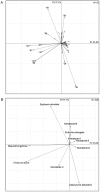Insights into the complex associations between MHC class II DRB polymorphism and multiple gastrointestinal parasite infestations in the striped mouse
- PMID: 22389675
- PMCID: PMC3289624
- DOI: 10.1371/journal.pone.0031820
Insights into the complex associations between MHC class II DRB polymorphism and multiple gastrointestinal parasite infestations in the striped mouse
Abstract
Differences in host susceptibility to different parasite types are largely based on the degree of matching between immune genes and parasite antigens. Specifically the variable genes of the major histocompatibility complex (MHC) play a major role in the defence of parasites. However, underlying genetic mechanisms in wild populations are still not well understood because there is a lack of studies which deal with multiple parasite infections and their competition within. To gain insights into these complex associations, we implemented the full record of gastrointestinal nematodes from 439 genotyped individuals of the striped mouse, Rhabdomys pumilio. We used two different multivariate approaches to test for associations between MHC class II DRB genotype and multiple nematodes with regard to the main pathogen-driven selection hypotheses maintaining MHC diversity and parasite species-specific co-evolutionary effects. The former includes investigations of a 'heterozygote advantage', or its specific form a 'divergent-allele advantage' caused by highly dissimilar alleles as well as possible effects of specific MHC-alleles selected by a 'rare allele advantage' (= negative 'frequency-dependent selection'). A combination of generalized linear mixed models (GLMMs) and co-inertia (COIA) analyses made it possible to consider multiple parasite species despite the risk of type I errors on the population and on the individual level. We could not find any evidence for a 'heterozygote' advantage but support for 'divergent-allele' advantage and infection intensity. In addition, both approaches demonstrated high concordance of positive as well as negative associations between specific MHC alleles and certain parasite species. Furthermore, certain MHC alleles were associated with more than one parasite species, suggesting a many-to-many gene-parasite co-evolution. The most frequent allele Rhpu-DRB*38 revealed a pleiotropic effect, involving three nematode species. Our study demonstrates the co-existence of specialist and generalist MHC alleles in terms of parasite detection which may be an important feature in the maintenance of MHC polymorphism.
Conflict of interest statement
Figures


Similar articles
-
Parasite-mediated selection of major histocompatibility complex variability in wild brandt's voles (Lasiopodomys brandtii) from Inner Mongolia, China.BMC Evol Biol. 2013 Jul 12;13:149. doi: 10.1186/1471-2148-13-149. BMC Evol Biol. 2013. PMID: 23848494 Free PMC article.
-
MHC class II DRB variability and parasite load in the striped mouse (Rhabdomys pumilio) in the Southern Kalahari.Mol Biol Evol. 2005 May;22(5):1254-9. doi: 10.1093/molbev/msi112. Epub 2005 Feb 9. Mol Biol Evol. 2005. PMID: 15703235
-
The functional importance of sequence versus expression variability of MHC alleles in parasite resistance.Genetica. 2012 Dec;140(10-12):407-20. doi: 10.1007/s10709-012-9689-y. Epub 2012 Nov 24. Genetica. 2012. PMID: 23180005
-
Major Histocompatibility Complex (MHC) Genes and Disease Resistance in Fish.Cells. 2019 Apr 25;8(4):378. doi: 10.3390/cells8040378. Cells. 2019. PMID: 31027287 Free PMC article. Review.
-
Evolution of MHC IIB Diversity Across Cichlid Fish Radiations.Genome Biol Evol. 2023 Jun 1;15(6):evad110. doi: 10.1093/gbe/evad110. Genome Biol Evol. 2023. PMID: 37314153 Free PMC article. Review.
Cited by
-
Expression levels of MHC class I molecules are inversely correlated with promiscuity of peptide binding.Elife. 2015 Apr 10;4:e05345. doi: 10.7554/eLife.05345. Elife. 2015. PMID: 25860507 Free PMC article.
-
Trichuris muris as a tool for holistic discovery research: from translational research to environmental bio-tagging.Parasitology. 2021 May 6;148(14):1-13. doi: 10.1017/S003118202100069X. Online ahead of print. Parasitology. 2021. PMID: 33952360 Free PMC article.
-
Major histocompatibility complex class II DAB alleles associated with intestinal parasite load in the vulnerable Chinese egret (Egretta eulophotes).Ecol Evol. 2016 Jun 7;6(13):4421-34. doi: 10.1002/ece3.2226. eCollection 2016 Jul. Ecol Evol. 2016. PMID: 27386085 Free PMC article.
-
Generalists and Specialists: A New View of How MHC Class I Molecules Fight Infectious Pathogens.Trends Immunol. 2018 May;39(5):367-379. doi: 10.1016/j.it.2018.01.001. Epub 2018 Jan 31. Trends Immunol. 2018. PMID: 29396014 Free PMC article. Review.
-
MHC class II variation in a rare and ecological specialist mouse lemur reveals lower allelic richness and contrasting selection patterns compared to a generalist and widespread sympatric congener.Immunogenetics. 2015 Apr;67(4):229-45. doi: 10.1007/s00251-015-0827-4. Epub 2015 Feb 18. Immunogenetics. 2015. PMID: 25687337 Free PMC article.
References
-
- Brooks DR, Hoberg EP. Systematics and emerging infectious diseases: From Management to solution. J Parasitol. 2006;92:426–429. - PubMed
-
- Weil ZM, Martin LB, II, Nelson RJ. Interactions among immune, endocrine, and behavioural response to infection. In: Morand S, Krasnov BR, Poulin R, editors. Micromammals and Macroparasites. Tokyo: Springer-Verlag; 2006. pp. 443–473.
-
- Stear MJ, Bairden K, Duncan JL, Holmes PH, McKellar QA, et al. How hosts control worms. Nature. 1997;389:27. - PubMed
-
- Mas-Coma S, Valero MA, Bargues MD. Effects of climate change on animal and zoonotic helminthiases. In: de La Rocque S, editor. Climate change: impact on epidemiology and control of animal disease. Rev Sci Tech Oie; 2008. pp. 443–452. - PubMed
-
- Behnke JM, Wakelin D. The survival of Trichuris muris in wild populations of its natural hosts. Parasitol. 1973;67:157–164. - PubMed
Publication types
MeSH terms
Substances
LinkOut - more resources
Full Text Sources
Research Materials

